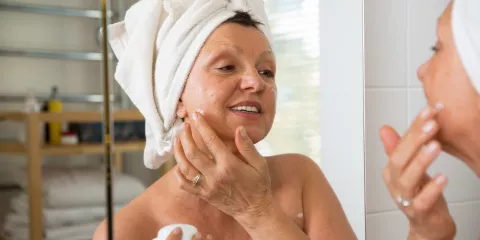
We typically don’t think about how our bodies move the way they do. We just know we can sit, stand, move about. That movement is possible thanks to our joints. We tend to take them for granted, especially when we’re young, not noticing them until we feel an ache or pain here or there.
But as we age, so do our joints. The Centers for Disease Control and Prevention reported that of people aged 45 to 64 years, 29.3% have reported doctor-diagnosed arthritis, but by age 65 or older, 49.6% reported doctor-diagnosed arthritis. Joint discomfort may make it more difficult to exercise and remain active, which is an important part of healthy aging. The good news is that there are ways to care for your joints as you age.
What Are Joints In The Body?
Our bodies are made to be active, to move. And the way that happens is through our joints. Without them, movement wouldn’t be possible, which is why joint health is so important. So let’s take a look at what joints are.
A joint is the part of the body where two or more bones meet to allow movement. Except for the hyoid bone in the throat, every bone in the body meets up with at least one other bone at a joint. In general, the more movement that’s possible through a joint, the higher the risk of injury as a greater range of movement reduces the strength of the joint.1
Joints are held together and supported by ligaments, which are tough bands of connective tissue and cartilage that prevents friction as the bones move against one another. Muscles are attached to the bones by tendons, which help facilitate movement and prevent damage to muscle tissues. In freely movable joints, the entire joint is enclosed inside a membrane filled with synovial fluid, which helps to provide extra cushioning against impact and reduce friction.1,2
Not all joints function in the same manner, however. So, what are the types of joints? There are three main types of joints described by how much movement they allow. Immovable joints are fixed where no movement occurs such as with the skull. Slightly movable allow for limited movement such as with your vertebrae in the spine. Next is freely movable, also known as synovial joints. These joints have synovial fluid that allows all parts of the joint to smoothly move against each other. An example would be your knees.1,2
The majority of our joints are freely movable. Of the freely movable joints, there are six types:
Ball and socket joint – the rounded head of one bone sits within the cup of another allowing movement in all directions. Examples include hip or shoulder joint or shoulder joint.
Saddle joint – enables movement back and forth and from side to side, but does not allow rotation. An example is the joint at the base of your thumb.
Hinge joint – this joint is like a door where the two bones open and close in one direction only (along one plane) Examples include your knee and elbow joints.
Condyloid joint – this allows movement, but no rotation. Examples include the jaw or finger joints.
Pivot or rotary joint – characterized by one bone that swivels around the ring formed by another bone. Examples include the first and second vertebrae in your neck and the joints between your ulna and radius bones.
Gliding or plane joints – only permits limited movement and is characterized by smooth surfaces that slip over one another. An example is your wrist joints.
All these joints give you the ability to be active, to sit, stand, walk, run, dance, even hug. But, as we age, our joints start to wear out. That’s why it’s important to care for our joints to help prevent many common joint issues.
Common Issues With Joints
It’s a simple fact of life, as we age, our bodies begin to wear down, and this includes our joints. As we get older, the connective tissue in our tendons and ligaments get stiffer. Combine that with a loss of muscle strength that happens as we age and become more sedentary, and you have increased pressure on the joints which can lead to common joint discomfort associated with aging.
The reality is that joint discomfort is quite common, which primarily affects the knees, shoulders, and hips. Joint discomfort however, can affect any of our joints like fingers, ankles, elbows, and toes.
What Helps Your Joints
So what can you do to encourage joint health as you age and promote healthy aging in general? There are many things you can do to maintain the health of your joints, including warming up before exercising, exercising routinely – but don’t overdo it, eating healthy, getting good quality sleep, managing stress, and taking vitamins, minerals, or supplements for joint health and overall well-being.
Six Tips to Help Your Joints:
Exercising routinely. Exercise is important to every area of physical health. Opt for low-impact workouts like the elliptical machine or swimming.5 These exercise methods can give you the same cardio output as running without the impact on your joints. Even so, always consult with your health care provider before starting any new exercise program.
Stretching. Flexibility helps you move easier no matter your age. Stretching at least three times a week is beneficial, but it’s important to not stretch when your muscles are cold. Before stretching, do a light warm-up, such as taking a short walk, to loosen up the joints, ligaments, and tendons.5 You might also enjoy yoga or tai chi. Both forms offer low-impact stretching of muscles while promoting healthy circulation and having a meditative quality which is great for reducing stress.
Lifting weights. Weight lifting or resistance training isn’t just for athletes or gym rats. As we age, our bodies begin to lose important muscle mass, which can negatively impact our joints as well as bone density. If you’re not sure where to start, talk with a certified personal trainer at your local fitness center.6
Icing. After intense or lengthy exercise, place an ice pack on your joints for up to 20 minutes.6 Ice is a natural pain reliever. It helps numb the aches and eases swelling. While you ice, you can do another healthy practice — relax!
Eating right. Eating a healthy diet rich in a variety of heart-healthy foods, like fruits, vegetables and whole grains as with a Mediterranean diet, can not only make you feel better, reduce your risk for certain diseases, and help you maintain a healthy weight, it also ensures you’re getting important vitamins and minerals to support healthy joints.
Taking supplements. There are many well known nutrients in supplements that have been shown to help maintain and promote joint health, including Vitamin D, calcium, magnesium, Omega-3 fatty acids and turmeric. It may also be beneficial to add a lipid-soluble antioxidant to your supplement regimen, like Kaneka Ubiquinol® which can reduce oxidative stress and promote cellular energy for overall wellness and healthy aging.
When shopping for supplements and vitamins, ensure that you are looking at reputable brands, or consult your health care professional for advice on supplements that could be of benefit to you.
Want to learn more? Download our FREE Healthy Diet & Supplement Guide!
With a few simple steps, you can help maintain your joint health while you age gracefully. For more tips on healthy aging, take a look at our Health Tips for your 50s or How to Stay Healthy in Your 40s.
Articles You Might Also Like
References
- https://www.betterhealth.vic.gov.au/health/conditionsandtreatments/joints
- https://www.healthline.com/health/how-many-joints-in-human-body
- https://www.webmd.com/healthy-aging/features/joints-change-age?src=rss_public#1
- https://www.webmd.com/pain-management/guide/joint-pain
- https://www.webmd.com/rheumatoid-arthritis/ra-relief-21/joints/slideshow-keep-joints-healthy
https://www.webmd.com/arthritis/arthritis-guide












